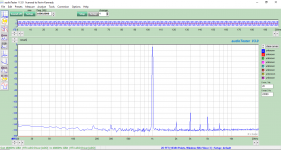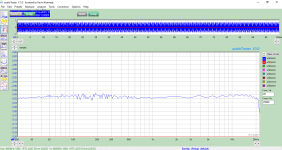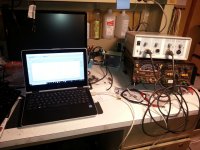Muuuaahhahahaaaaa!!! I received my Jensalyzer (with the mod) today. Looks great, built like a tank! Looking back to when Jens started telling us about his idea, delivering such a fine product is a great achievement. Congratulations to Jens and RTX!
Just a minor glitch: the Quick Start Guide says the box should contain a mains cable, USB cable, Certificate of Conformity and a Calibration report. None of these were included in the box -- is this just me? I don't mind the missing cables (there are enough in my workshop), but the paper thingies would be nice to have.
Just a minor glitch: the Quick Start Guide says the box should contain a mains cable, USB cable, Certificate of Conformity and a Calibration report. None of these were included in the box -- is this just me? I don't mind the missing cables (there are enough in my workshop), but the paper thingies would be nice to have.
No, nothing missing, documentation and accessories are not included. The group buy units are calibrated at the factory and include quick start and fuses and that's it. I guess they had to leave something out for the 60% discount we got as part of the GB.
Mine has warmed up sufficiently that it should now be safe to unpack and hook it up.
Mine has warmed up sufficiently that it should now be safe to unpack and hook it up.
Hi mbrennwa,
THe information you seek is available by download from the RTX site. There are links in a document if you look through the thread. If I could remember, I would tell you.
-Chris
THe information you seek is available by download from the RTX site. There are links in a document if you look through the thread. If I could remember, I would tell you.
-Chris
It's up and running, seems to work quite well. Performance in all areas is very good, and in some ways exemplary.
The frequency response is damned flat, about as good as I have ever seen. (Audio Precision territory)
Noise floor is low, residuals are probably close to the limits of the ADC.. Performance holds up well to the -3dBFS region (about -118dBFS at the third harmonic which is the worst case on mine)
The generator is exceptionally clean.
There is a little cross-talk between the right channel out and left channel in that is not affected by the attenuator, but in practice it is so far down I doubt it is a problem. (-87dB relative to the fundamental on the driven channel)
The calibration seems to be quite accurate according to my now out of calibration Keithley 2002 (it hasn't been recalibrated since the calibration expired in 2008) measured 1.00122Vrms out at the 0dBFS setting at 1kHz.
First graph is linearity at -3dBFS output and inputs set to 0dBV range. (Averaging 8)
Second graph is the frequency response at -3dBFS, 0dBV selected range on output and input, and DC coupling. (Wow, it's really good, like AP territory, 256 points)
Third is cross talk between right output and left input. (averaging 8)
This is really nice performance overall, and a steal for what we paid.
The frequency response is damned flat, about as good as I have ever seen. (Audio Precision territory)
Noise floor is low, residuals are probably close to the limits of the ADC.. Performance holds up well to the -3dBFS region (about -118dBFS at the third harmonic which is the worst case on mine)
The generator is exceptionally clean.
There is a little cross-talk between the right channel out and left channel in that is not affected by the attenuator, but in practice it is so far down I doubt it is a problem. (-87dB relative to the fundamental on the driven channel)
The calibration seems to be quite accurate according to my now out of calibration Keithley 2002 (it hasn't been recalibrated since the calibration expired in 2008) measured 1.00122Vrms out at the 0dBFS setting at 1kHz.
First graph is linearity at -3dBFS output and inputs set to 0dBV range. (Averaging 8)
Second graph is the frequency response at -3dBFS, 0dBV selected range on output and input, and DC coupling. (Wow, it's really good, like AP territory, 256 points)
Third is cross talk between right output and left input. (averaging 8)
This is really nice performance overall, and a steal for what we paid.
Attachments
Hi Kevin,
Oh no! Someone might be out by as much as 1.22 mV!
Or, it might be a touch of noise in the area. I'd say that is about as close to perfect as you can ever expect, and not too shabby considering they are using some piece of equipment on the other side of the pond from you. If you look at your uncertainties for the Keithley (or my HP), this error is probably well inside those limits. Never mind whatever they use at RTX!
-Chris
Oh no! Someone might be out by as much as 1.22 mV!
Or, it might be a touch of noise in the area. I'd say that is about as close to perfect as you can ever expect, and not too shabby considering they are using some piece of equipment on the other side of the pond from you. If you look at your uncertainties for the Keithley (or my HP), this error is probably well inside those limits. Never mind whatever they use at RTX!
-Chris
Yeah 1.00122V is about 1200ppm, the Keithley has an AC amplitude accuracy about +/-0.02%+0.02% of reading over 50Hz - 2kHz.. DC accuracy is considerably better - in all cases below 40ppm, transfer accuracy is in the low single digits.
I have made a description of how to disassemble and reassemble the RTX6001, see attached. I have also re-posted the description of the overvoltage protection modification to have both descriptions available in one post.
Let me know if further details are needed (to be able to do the mod).
Jens
Let me know if further details are needed (to be able to do the mod).
Jens
Attachments
Muuuaahhahahaaaaa!!! I received my Jensalyzer (with the mod) today. Looks great, built like a tank! Looking back to when Jens started telling us about his idea, delivering such a fine product is a great achievement. Congratulations to Jens and RTX!
Just a minor glitch: the Quick Start Guide says the box should contain a mains cable, USB cable, Certificate of Conformity and a Calibration report. None of these were included in the box -- is this just me? I don't mind the missing cables (there are enough in my workshop), but the paper thingies would be nice to have.
Similar observation, no problem at all for me not having cables provided but may be better that the quick start guide at 1.2 therefore doesn't say they are included?
Hi JensH,
Santa did come to me today with my RTX 6001 😀. Very nice instrument 😀 ! Thank you for your efforts, it is a wonderful instrument. I have now to let it arrive to room temperature before to be connected 😡 and that is a slow process ...
Thank you again JensH ! I am very happy to have this baby home !
Best regards
rephil
Santa did come to me today with my RTX 6001 😀. Very nice instrument 😀 ! Thank you for your efforts, it is a wonderful instrument. I have now to let it arrive to room temperature before to be connected 😡 and that is a slow process ...
Thank you again JensH ! I am very happy to have this baby home !
Best regards
rephil
Great support so far on this issue. I'm very excited to get this fixed up and able to take advantage of this unit 🙂
@ JensH
What kind of wires are needed (enameled wires...) or these are included in the packet of the pcbs.
Let me know if further details are needed (to be able to do the mod).Jens
What kind of wires are needed (enameled wires...) or these are included in the packet of the pcbs.
Last edited:
Yesterday I did opened the analyzer for start to give a glance ...
Really a good construction and a lot of skill for preserve any possible noise and interference, really impressive ...
Really a good construction and a lot of skill for preserve any possible noise and interference, really impressive ...
cross talk?
Early days so need to analyse further but an initial observation is that I'm seeing cross talk between the right out and left in. It is attenuator sensitive on the left in (and to some extent attenuator on right out) so suggests coupling is mainly before the input attenuator? Right in seems to be completely unaffected hence why I'm suspicious. Note that this is with nothing connected to the unit and the outputs left floating but that seems a reasonable test of the unit's stand alone performance. Saw one other comment that touched on this point. Any thoughts anyone?
Early days so need to analyse further but an initial observation is that I'm seeing cross talk between the right out and left in. It is attenuator sensitive on the left in (and to some extent attenuator on right out) so suggests coupling is mainly before the input attenuator? Right in seems to be completely unaffected hence why I'm suspicious. Note that this is with nothing connected to the unit and the outputs left floating but that seems a reasonable test of the unit's stand alone performance. Saw one other comment that touched on this point. Any thoughts anyone?
Above was with unit connected to desk top. Have now set it up on lap top (running on battery) and the above phenomena isn't there. Weird and needs more investigation but strongly indicates the problem is on my side.
Early days so need to analyse further but an initial observation is that I'm seeing cross talk between the right out and left in. It is attenuator sensitive on the left in (and to some extent attenuator on right out) so suggests coupling is mainly before the input attenuator? Right in seems to be completely unaffected hence why I'm suspicious. Note that this is with nothing connected to the unit and the outputs left floating but that seems a reasonable test of the unit's stand alone performance. Saw one other comment that touched on this point. Any thoughts anyone?
I had a strange interference and spuries on the left channel and after that I asked to Jens, he said me that could be an USB problem ( never connect the RTX to an USB hub ) and/or a too slow pc and effectively the problem was that.
I had connected it to an USB hub on a old pc, this way I do tried to connect the unit directly to an USB port of another pc and magically the problem disapperead completly.
If this can be useful ...
Thanks for your input. Turns out problem isn't there when I run it on my laptop so pretty conclusive that it's my desk top PC set up. desktop PC is getting old but is reasonable spec even for its age but must be under suspicion as the phenomena isn't being reported by others who are looking into the RTX's performance in considerable detail.
Early days so need to analyse further but an initial observation is that I'm seeing cross talk between the right out and left in. It is attenuator sensitive on the left in (and to some extent attenuator on right out) so suggests coupling is mainly before the input attenuator? Right in seems to be completely unaffected hence why I'm suspicious. Note that this is with nothing connected to the unit and the outputs left floating but that seems a reasonable test of the unit's stand alone performance. Saw one other comment that touched on this point. Any thoughts anyone?
There is some amount of crosstalk between the right output and the left input, due to the proximity. The worst case is when the inputs are left floating, since the high impedance attenuator will pick up some signal from the generator section.
With a low impedance source connected to the input, the crosstalk will be reduced.
The Main Board has been prepared for mounting shields over the input sections, but I didn't feel that they were necessary, so no shields have been fitted.
- Status
- Not open for further replies.
- Home
- Group Buys
- GB for RTX6001 Audio Analyzer with AK5394A and AK4490



